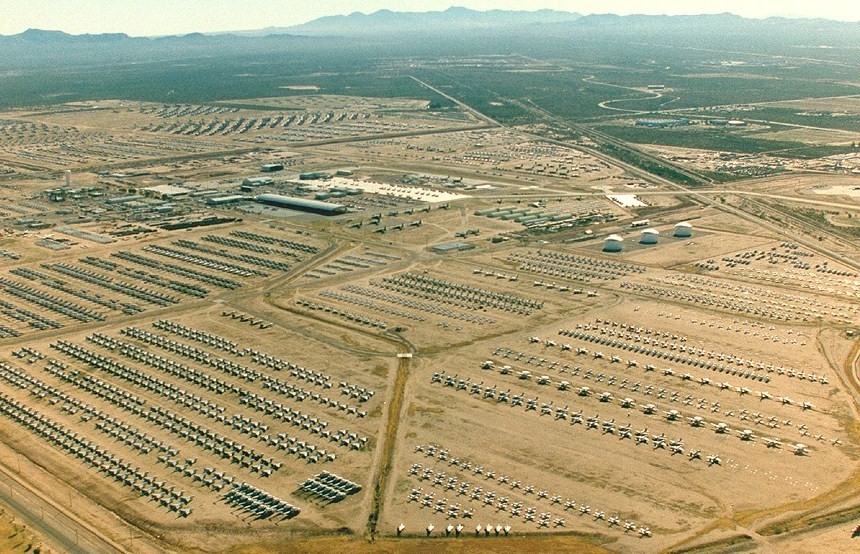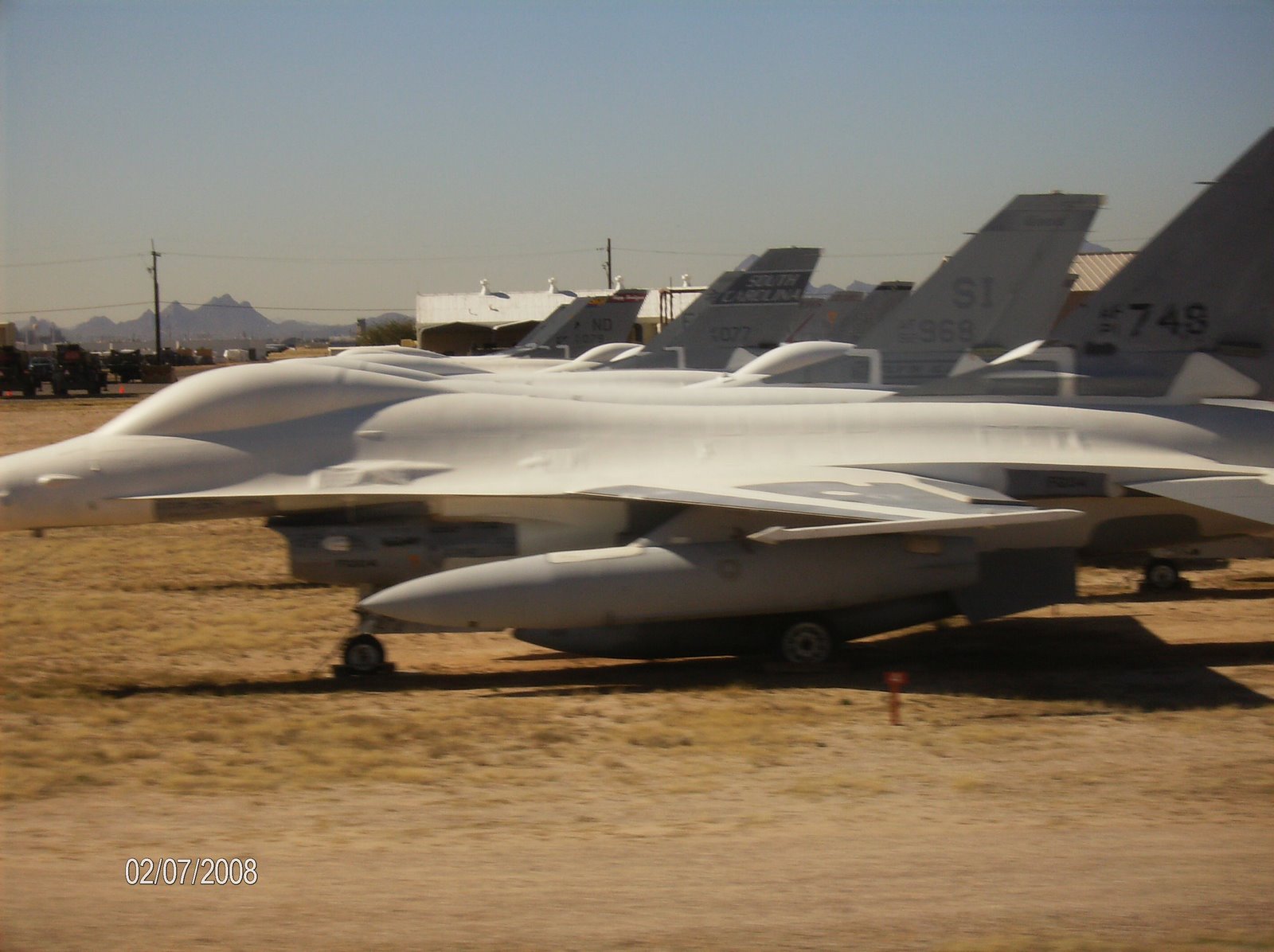
Arlington National Cemetery in Washington D.C., is the most recognized resting place for those that have served our country. But near Tucson, Arizona, there is a resting place of another kind – one that houses monuments that chronicle American history from a different perspective. It is officially called the Aerospace Maintenance And Regeneration Center, or AMARC - but it is more widely known as the Airplane Graveyard.

Photo Credit: Gerhard Plomitzer
AMARC is a joint service facility managed by the US Air Force Material Command located in Tucson. It is an aerospace storage and maintenance facility adjoining Davis-Monthan Air Force Base which provides a service to all branches of the US military (Air Force, Navy, Marines, Coast Guard and Army), as well as other national agencies. It is the largest "airplane graveyard" in the world, currently housing over 4,200 planes.

Photo Credit: Gerhard Plomitzer
The facility was originally established in April 1946 as the 4105th Army Air Force Unit, designated as a storage location for the large number of aircraft no longer required following the end of the Second World War. This location was chosen because of its dry, arid climate which reduces corrosion - as well as the hard earth that exists here, which enables the storage of thousands of heavy aircraft without having to pour acres of concrete.
In the 1950's the center supported the US in the Korean conflict by providing aircraft and aircraft spares. When the hostilities ceased, storage was once again provided for the surplus aircraft. In the mid 1960s during the escalation of the Vietnam conflict, the center was again tasked with providing aircraft and parts. As this conflict started winding down, vast quantities of aircraft were once more funneled back for storage and reclamation.

In 1981 the center once again widened its role by taking on the responsibility of preserving TITAN II, THOR and ATLAS missiles used by the Space Division for its satellite launches. A new storage facility was added at Norton Air Force Base in California, specifically for this purpose. The center's name was changed in October 1985 to the Aerospace Maintenance And Regeneration Center - its current designation.
Despite its tag as a graveyard, planes are not necessarily sent here to die. Aircraft are carefully prepared for storage, with efforts made to preserve them for possible reinstatement into active duty. Even planes that may not ever see flight time again may provide valuable replacement parts for other aircraft currently in service.

Photo Credit: Andy Martin
Prior to storage, aircraft are made safe by the removal of hazardous and dangerous components or materials. High-pressure systems are bled and spring-loaded systems are relieved, survival kits are removed and any remaining weapons are removed for specialized storage. During this process a complete inventory of the aircraft is performed to document any missing items. Classified items are removed and sent to a secure storage area. Items subject to deterioration are placed in storage or are disposed of.
The aircraft's fuel systems are drained, the resulting fuel will be stored for future re-use. The empty fuel tanks are filled using preservation oil. The oil is pumped through the entire fuel system to preserve all of its components (tanks, pipes, pumps, etc.). The engine is run to fully circulate the pure oil, and then the surplus oil is removed and recovered for future use. The aircraft is then thoroughly cleaned and inspected for corrosion.
Most of the aircraft at AMARC are protected by a vinyl compound called Spraylat which is sprayed on as two coats. The first coat is black in color and seals the aircraft to protect its systems from dust, moisture, animals and insects. The second coat, which is white in color, helps to reflect sunlight and heat to protect the aircraft from excessive internal temperatures. Before the Spraylat is applied the engine intake and exhaust areas have desiccant material installed into them, and other openings are filled with barrier material or barrier tape. All access panels, doors, plates and other small openings are sealed using tapes. Brushable Spraylat is used in conjunction with the barrier materials and tape to ensure a complete seal.

After all this work has been completed the internal temperatures will remain within 10 to 15 degrees F of the outside air temperature. Without this protection the internal temperatures would reach in access of 200 degrees and this would result in the rapid deterioration of the plastic, rubber and heat sensitive components. The aircraft are then towed to the designated storage position and are secured.
Because of the reclamation efforts that go on here with aircraft sometimes being stripped down to their frames for spare parts - the facility is also often referred to as "The Boneyard." However the AMARC works hard to promote the fact that it performs a very key service for the military, and is a cost effective and tax saving operation - and it doesn't just work in spare parts. Many of the stored aircraft can be returned to an operational status in a short period of time and there is a continual process of anti-corrosion and re-preservation work which keeps the aircraft in a stable condition during their stay.

But AMARC does indeed do a lot of reclamation work, as well as the eventual disposal of spent airframes. Some aircraft leave the reclamation area to become instructional aircraft, targets on Army or Air Force ranges, museum exhibits, or display pieces. However, most end up being smelted down into ingots by nearby metal processors.
The Pima Air&Space Museum, adjacent to AMARC, offers exclusive tours of the facility Monday-Friday. In addition, independent pilots in the area also offer "fly over" tours - which may be the best way to see the vast size and significance of this living piece of history.

To roam around the AMARC facility as shown above with the help of Google, check out the link below:
http://maps.google.com/maps?ll=32.150899,-110.834026&spn=0.009034,0.015192&t=k&hl=en
Sources: The AMARC Experience






Comments